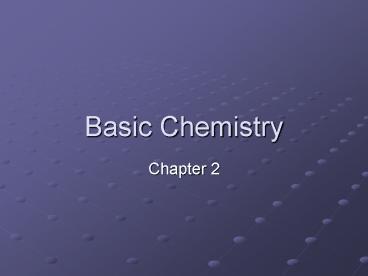Basic Chemistry - PowerPoint PPT Presentation
1 / 29
Title:
Basic Chemistry
Description:
Basic Chemistry Chapter 2 – PowerPoint PPT presentation
Number of Views:638
Avg rating:3.0/5.0
Title: Basic Chemistry
1
Basic Chemistry
- Chapter 2
2
Atoms
- Matter
- All matter is made of atoms
- Atoms
- Atoms consist of electrons, protons, and neutrons
- Elements
- Elements are pure substances made of only one
kind of atom
3
Chemical Bonding
- Covalent Bonds
- Molecules are groups of atoms linked by covalent
bonds - Hydrogen Bonds
- Hydrogen bonding occurs between polar molecules
- Ionic Bonds
- An ion is a charged atom or molecule. Ions of
opposite charge may form an ionic bond
4
Water in Living Things
- Storage of Water
- Water, which is essential for life, stores heat
efficiently and binds to itself and other
substances - Cohesion sticks to itself
- Adhesion different substances stick together
5
Aqueous Solutions
- Polarity
- Water dissolves polar molecules and ionic
compounds - Acids and Bases
- Acids increase the hydrogen ion concentration of
a solution. Bases decrease the hydrogen ion
concentration of a solution. The pH scale
measures the strength of acids and bases
6
Carbon Compounds
- Carbohydrates
- Carbohydrates, such as glucose, are a source of
energy and are used as structural materials in
organisms - Lipids
- Lipids are nonpolar molecules that store energy
and are an important part of cell membranes - Proteins
- Proteins are chains of amino acids. The sequence
of amino acids determines a proteins shape and
specific function - Nucleic Acids
- Nucleic acids store and transmit hereditary
information - ATP
- ATP is the main energy currency of cells
7
Molecular Chains
- Carbon chains can be 1 or 2 carbon atoms or
thousands of carbon atoms - Smaller molecules bond together and are known as
a polymer - Many polymers are formed by condensation H
removed from one, OH removed from another so H2O
is pulled out - Opposite is called Hydrolysis
8
Condensation
9
Hydrolysis
10
Carbohydrates
- Made of Carbon, Hydrogen, and Oxygen only in a
ratio of 121 - C6H12O6,
- Provide energy
11
- Monosaccharide building block
- Called Simple Sugars (Glucose, Fructose)
12
- Disaccharide 2 monosaccharides
- Fructose Glucose ? Sucrose
13
- Polysaccharide polymer of many monosaccharides
- Starch, Glycogen, and Cellulose
14
Lipids
- Mostly Carbon and Hydrogen, small amount of
Oxygen - Nonpolar molecules so dont dissolve in water
- Energy storage, protection, insulation
- Major component of membranes
15
- Fatty Acids and Glycerol building block
16
- If all Carbons have single bonds saturated
- Fats from animals solids at room temp.
17
- If there is a double bond unsaturated
- Oils from plants Liquids are room temp.
(Healthier?)
18
- More than 1 double bond polyunsaturated
19
(No Transcript)
20
Proteins
- Contain Carbon, Hydrogen, Oxygen, Nitrogen, and
sometimes Sulfur - Amino Acids building block
- 20 Combine using condensation and form a peptide
bond - Sequence determines protein
- Tissue and organ structure and cell metabolism
21
Protein Examples
- Hemoglobin
- Carries oxygen in your blood
- Made in bone marrow
- Contains iron too little iron anemic
22
Protein Examples
- Insulin
- Hormone that regulates the amount of sugar in
your blood treats diabetes - Secreted by pancreas
- Tells other cells to absorb glucose (no insulin
no energy absorbed) - These cells (liver, muscle, and fat) then store
it as glycogen and stop using fat as energy - No or low Insulin, no glucose uptake, fat used as
energy - Type I Diabetes Insulin deficiency shots
- Type II Insulin resistance other methods
23
Special Protein Enzymes
- Protein that changes the rate of a chemical
reaction (may speed up) - Many lower the Activation Energy
- Activity depends on temperature, enzyme
concentration, and pH - Specific to certain substrates
- Works like a lock and key
- Amino acids make proteins (enzyme) folded in a
certain way which determines job
24
(No Transcript)
25
Energy for Life Processes
- Energy in Chemical Reactions
- Chemical Reactions absorb or release energy
- Activation Energy
- Starting a chemical reaction requires activation
energy
26
Enzyme-Substrate Complex
27
Nucleic Acids
- Stores cellular information in the form of a
code - DNA and RNA
- Nucleotides building blocks
- Carbon, Hydrogen, Nitrogen, and Phosphorous in 3
parts - Nitrogenous Base
- Simple Sugar
- Phosphate Group
28
(No Transcript)
29
How to Identify
- Proteins turn a blue Biuret solution to
pink-purple - Starches (carbohydrates) show up bluish/black
when drops of iodine are added - Sugars (carbohydrates) turn a blue Benedicts
solution an orange-brown - Lipids leave a grease spot on brown paper































